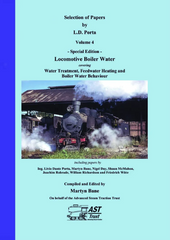Selection of Papers by L.D. Porta - Volume 4. Locomotive Boiler Water, covering Water Treatment, Feedwater Heating and Boiler Water Behaviour
The 4th Volume of Papers from L.D. Porta, and others, distilling his and their ideas on Water Treatment, Feedwater Heating and Boiler Water Behaviour.
Compiler and Editor, Martyn Bane, quotes Porta in introducing the book with the following words:
“What counts is what one has in the boiler, not what one feeds into it.”
Ing. L.D.Porta’s simple statement outlines, in just a few words, what became his approach to boiler water treatment. It seems at odds with accepted thinking on the topic, what did he mean by this? Very simply, if the boiler water chemistry is within a defined range the nature of the feedwater is of no concern.
It has been known since the 1970s with certainty, but for a few decades previously less clearly, that with a certain boiler water chemistry it is possible, in a practical sense, to prevent scale formation, corrosion and caustic embrittlement. The use of Porta’s system also ensures fully mobile, non-adherent sludge formation and the production of technically pure steam, foaming and boiler water swelling are controlled.
The boiler water chemistry is controlled through the addition of chemicals dosed at a defined rate, whilst the locomotive is in service, regardless of feedwater conditions. Naturally, the testing of boiler water samples needs to be undertaken to ensure success. The test results indicate if extra alkalinity needs to be added or if a boiler blowdown is required. Boiler water alkalinity and dissolved solids concentration are the two factors that are controllable conditions.
The implications of this are clear. Feedwater constantly varies at and between watering points. There is nothing which can be done to change this unless a form of external treatment is applied, which the above suggests is not necessary. Therefore why be concerned by feedwater variation? Trying to accommodate any variations through adapting treatment dosing is always going to be, at best, difficult and inadequate. History has shown this to be the case, but it remains a common approach.
This volume contains much information supporting Porta’s statement and approach.
Such is covered in Porta’s 1975 “Water Treatment” paper included in the book. However, it may be seen from its Table of Contents that the book covers a much broader canvas, including papers on boiler water circulation and on boiler water pre-heating, and papers by other authors, including three papers by Martyn himself.
For those who don’t know him or of him, Martyn was an early advocate of Porta’s water treatment practice and set up his own company in the early 2000s to market the technology within the UK and beyond. The company failed to prosper, partly because of difficulties in obtaining a satisfactory formulation of antifoam that allowed Porta’s recommended alkalinity and total dissolved solid levels to be obtained, but largely because of challenges persuading steam locomotive owners and operators to break with past practices and to adopt new ones. Notwithstanding, Martyn successfully demonstrated what Porta Treatment could achieve by applying it over a period of several years to the boiler of ex-GWR 4-6-0 No 6024 King Edward I, in the maintenance and operation of which Martyn was heavily involved. This he describes in one of his papers here.
"This volume is an essential read for anyone with a serious interest in steam locomotives, water treatment and their continued operation in the 21st Century". It is aimed at full size locomotives, but does also have numerous links to smaller scale practice, down to at least 3 1/2 inch" gauge.
505 pages, numerous drawings, schematics and colour photographs. Paperback.
Also these books come directly from a print on demand supplier; this means they take slightly longer to ship.












